
- Homepage
- Binding
- Cloth (51)
- Cloth & Boards (2)
- Disbound (3)
- Fine Binding (203)
- Framed (2)
- Good (8)
- Hardback (114)
- Hardcover (1110)
- Hardcover / (4)
- Hardcover W / Jacket (3)
- Leather (497)
- Leather / Hardcover (4)
- Manuscript (26)
- Original Copy (99)
- Paperback (6)
- Pigskin (2)
- Softcover (3)
- Softcover, Wraps (86)
- Spiral (2)
- Vellum (54)
- ... (3090)
- Genre
- Language
- Publisher
- Antiquity (47)
- Cassell (7)
- Collector Books (12)
- Collier (5)
- David Mckay (6)
- Doubleday (6)
- Estes And Lauriat (9)
- Frank Leslie (6)
- Funk & Wagnalls (9)
- Grosset & Dunlap (22)
- Harper & Brothers (13)
- Lille, Blocquel (7)
- Macmillan (14)
- Macmillan And Co. (12)
- Passmore & Alabaster (6)
- Selected (6)
- The Century Company (9)
- Transylvania Amira (7)
- Unknown (12)
- Various (20)
- ... (5134)
- Topic
- Year Printed
Rare Antique Ancient Egyptian Statue God Anubis Book Dead+Canopic jar13861349BC
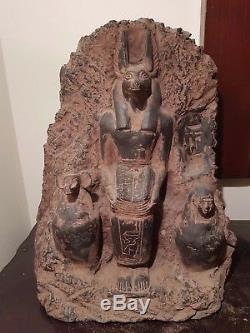
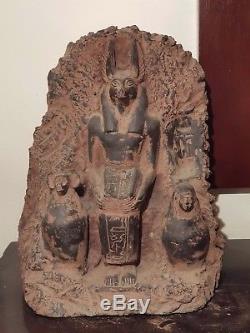
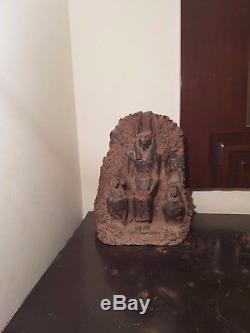
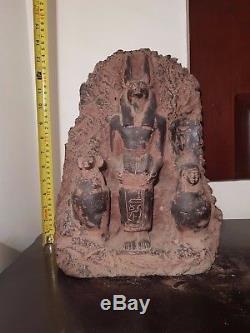
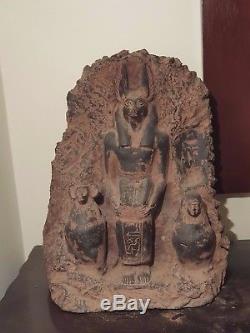
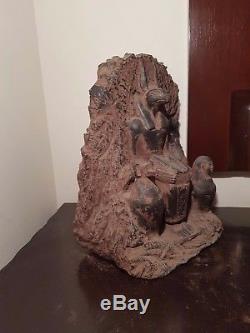
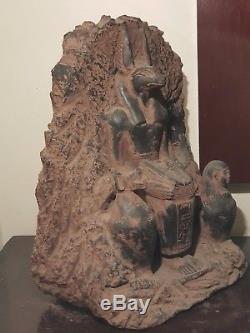
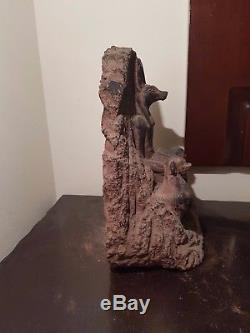
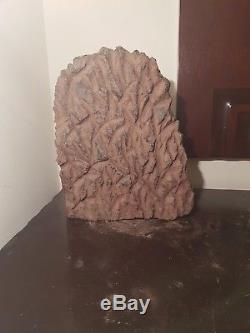
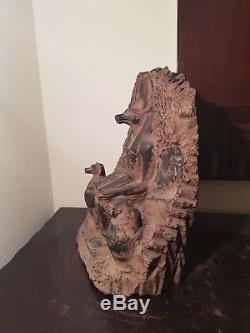
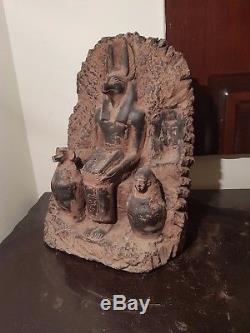
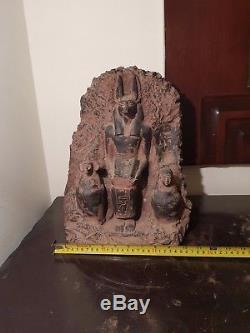


These is one of our best Antiques. Since it shows God Anubis while sitting on his Throne while he is opening Book of Dead infront of Him while on his both sides Canopic Jars.
Since it shows while King Amenhotep has been Dead while God Anubis is very sad while he has just mummified his body to stay forever while he is reading infront of his body sacred words from Book of Dead while he is reading from Book of Dead sacred book while will help the soul of king Amenhotep to fly freely and live good life After death also to be taken to heaven while at his both sides Canopic Jars which he offers for King Amenhotep after his life. Since he has on his both sides 2 canopic jars which will offer to the king since he has on right side NeithImsety which is with Human head which they used to put inside liver of king while on the left side you can see canopic jar with Head of Baboon which is Hapi which they used to put inside lungs. Since it shows God Anubis is very sad while sitting sad for the death of king Amenhotep while reading from Book of Dead sacred words to make good life for the king after death at his after life also to be taken to heaven directly also it shows while offering the king gift which is canopic jars to put inside his organs such statues were made after king Amenhotep death directly also was taken to his tomb. #×× Ancient Egyptian God Anubis.
God of cemeteries and embalming. Anubis god associated with mummification and the afterlife in ancient Egyptian religion, usually depicted as a canine or a man with a canine head (dog or jackal head). Archeologists identified the sacred animal of Anubis as an Egyptian canid, that at the time was called the golden jackal. Like many ancient Egyptian deities, Anubis assumed different roles in various contexts.Depicted as a protector of graves as early as the First Dynasty c. 2890 BC, Anubis was also an embalmer he was replaced by Osiris in his role as lord of theunderworld. One of his prominent roles was as a god who ushered souls into the afterlife.
He attended the weighing scale during the "Weighing of the Heart, " in which it was determined whether a soul would be allowed to enter the realm of the dead. Despite being one of the most ancient and "one of the most frequently depicted and mentioned gods" in the Egyptian pantheon, Anubis played almost no role in Egyptian myths.
Symbolized both rebirth and the discoloration of the corpse after embalming a "jackal" was chosen to protect the dead. The oldest known textual mention of Anubis is in the Pyramid Texts of the Old Kingdom where he is associated with the burial of the pharaoh.
The Old Kingdom, Anubis was the most important god of the dead. He was replaced in that role by Osiris during the Middle Kingdom. Tomb paintings depict him holding the hand of deceased persons to guide them to Osiris. Contrast to real wolves, Anubis was a protector of graves and cemeteries. Several epithets attached to his name in Egyptian texts and inscriptions referred to that role. Khenty-imentiu, which means "foremost of the westerners" and later became the name of adifferent wolf god, alluded to his protecting function because the dead were usually buried on the west bank of the Nile. He took other names in connection with his funerary role, such as "He who is upon his mountain" (tepy-dju-ef) keeping guard over tombs from above and "Lord of the sacred land" (neb-ta-djeser), which designates him as a god of the desert necropolis. As "He who is in the place of embalming" (imy-ut), Anubis was associated withmummification. He was also called "He who presides over the god's pavilion" (khanty-she-netjer), in which "pavilion" could be refer either to the place where embalming was carried out, or the pharaoh's burial chamber. One of the roles of Anubis was as the Guardian of the Scales. The critical scene depicting the weighing of the heart, in theBook of the Dead, shows Anubis performing a measurement that determined whether the person was worthy of entering the realm of the dead (the underworld, known as Duat). By weighing the heart of a deceased person against Ma'at (or "truth"), who was often represented as an ostrich feather, Anubis dictated the fate of souls. Souls heavier than a feather would be devoured by Ammit, and souls lighter than a feather would ascend to a heavenly existence.Canopic jars were used by the ancient Egyptians during the mummificaton process to store and preserve the viscera of their owner for the afterlife. They were commonly either carved from limestone or were made of pottery or hammer stone. These jars were used by the ancient Egyptians from the time of the Old Kingdomuntil the time of the Late Period or thePtolemaic Period, by which time the viscera were simply wrapped and placed with the bo The viscera were not kept in a single canopic jar: each jar was reserved for specific organs. Canopic jars of the Old Kingdom were rarely inscribed, and had a plain lid.
In the Middle Kingdom inscriptions became more usual, and the lids were often in the form of human heads. By the Nineteenth dynasty each of the four lids depicted one of the four sons ofHorus, as guardians of the organs. The canopic jars were four in number, each for the safekeeping of particular human organs: the stomach, intestines, lungs, and liver, all of which, it was believed, would be needed in the afterlife. There was no jar for the heart: the Egyptians believed it to be the seat of the soul, and so it was left inside the body As it shows from front with heiroglyphic story of dead person that he was living in peace during his life doing good things and hope god protect him after life and take him to heaven also you can see cobra is sculptured on jar to protect it and protect the liver. Many sets of jars survive from this period, in alabaster, aragonite, calcareous stone, and blue or green glazed porcelain and green hammer stone The sons of Horus were also the gods of the cardinal compass points.
Each god was responsible for protecting a particular organ, and was himself protected by a companion goddess. ×Hapi, the baboon-headed god representing the north, whose jar contained the lungs and was protected by the goddess. ×NephthysDuamutef, the jackal-headed god representing the east, whose jar contained the stomach and was protected by the goddess.
×NeithImsety, the human-headed god representing the south, whose jar contained the liver and was protected by the goddess Isis. ×Qebehsenuef, the falcon-headed god representing the west, whose jar contained the intestines and was protected by the goddess Serqet. Book of the Dead is an ancient Egyptian funerary text, used from the beginning of theNew Kingdom (around 1550 BCE) to around 50 BCE. The original Egyptian name for the text, transliterated rw nw prt m hrw is translated as Book of Coming Forth by Day. Another translation would be Book of Emerging Forth into the Light. "Book" is the closest term to describe the loose collection of textsconsisting of a number of magic spells intended to assist a dead person's journey through the Duat, or underworld, and into the afterlife and written by many priests over a period of about 1000 years. The original Egyptian name for the text, transliterated rw nw prt m hrw, is translated as Book of Coming Forth by Day."Book" is the closest term to describe the loose collection of texts consisting of a number of magic spells intended to assist a dead person's journey through the Duat, or underworld, and into the afterlife and written by many priests over a period of about 1000 years. The Book of the Dead was part of a tradition of funerary texts which includes the earlierPyramid Texts and Coffin Texts, which were painted onto objects, not papyrus.
Some of the spells included were drawn from these older works and date to the 3rd millennium BCE. Other spells were composed later in Egyptian history, dating to the Third Intermediate Period (11th to 7th centuries BCE). A number of the spells which made up the Book continued to be inscribed on tomb walls and sarcophagi, as had always been the spells from which they originated. The Book of the Dead was placed in the coffin or burial chamber of the deceased.There was no single or canonical Book of the Dead. The surviving papyri contain a varying selection of religious and magical texts and vary considerably in their illustration. Some people seem to have commissioned their own copies of the Book of the Dead, perhaps choosing the spells they thought most vital in their own progression to the afterlife. TheBook of the Dead was most commonly written in hieroglyphic or hieratic script on a papyrusscroll, and often illustrated with vignettesdepicting the deceased and their journey into the afterlife.
The Book of the Dead is made up of a number of individual texts and their accompanying illustrations. Most sub-texts begin with the word ro, which can mean mouth, speech, a chapter of a book, spell, utterance, or incantation. This ambiguity reflects the similarity in Egyptian thought between ritual speech and magical power.
In the context of the Book of the Dead, it is typically translated as either "chapter" or "spell". In this article, the word "spell" is used. At present, some 192 spells are known, though no single manuscript contains them all.
They served a range of purposes. Some are intended to give the deceased mystical knowledge in the afterlife, or perhaps to identify them with the gods: for instance, Spell 17, is an obscure and lengthy description of the god Atum. Others are incantations to ensure the different elements of the dead person's being were preserved and reunited, and to give the deceased control over the world around him.
Still others protect the deceased from various hostile forces, or guide him through the underworld past various obstacles. Famously, two spells also deal with the judgement of the deceased in theWeighing of the Heart ritual. Such spells as 26-30, and sometimes spells 6 and 126 relate to the heart, and were inscribed on scarabs. The texts and images of the Book of the Deadwere magical as well as religious.Magic was as legitimate an activity as praying to the gods, even when the magic was aimed at controlling the gods themselves. Indeed, there was little distinction for the Ancient Egyptians between magical and religious practice.
The concept of magic (heka) was also intimately linked with the spoken and written word. The act of speaking a ritual formula was an act of creation;there is a sense in which action and speech were one and the same thing. The magical power of words extended to the written word. Hieroglyphic script was held to have been invented by the god Thoth, and the hieroglyphs themselves were powerful. Written words conveyed the full force of a spell.This was even true when the text was abbreviated or omitted, as often occurred in later Book of the Dead scrolls, particularly if the accompanying images were present. The Egyptians also believed that knowing the name of something gave power over it; thus, the Book of the Dead equips its owner with the mystical names of many of the entities he would encounter in the afterlife, giving him power over them. The spells of the Book of the Dead made use of several magical techniques which can also be seen in other areas of Egyptian life.
A number of spells are for magical amulets, which would protect the deceased from harm. In addition to being represented on a Book of the Dead papyrus, these spells appeared on amulets wound into the wrappings of a mummy. Everyday magic made use of amulets in huge numbers.
Other items in direct contact with the body in the tomb, such as headrests, were also considered to have amuletic value. A number of spells also refer to Egyptian beliefs about the magical healing power of such book.He has to confront a formidable array of gods: Bone-Crusher, Shining-Tooth, Blood-Consumer, Flint-Eyes, Entrail-Consumer and many others with less frightening names assembled here from many places all over Egypt. He declares himself innocent of wrong-doing towards the gods and his fellow men. These protestations of guiltlessness of trespasses against society and cultic rules remained remarkably unchanged during the course of history. They, and similar passages in the Instructions literature, are accepted as being the standard of ancient Egyptian ethical behaviour.
The writing down of these declarations and the knowledge of the gods' names was powerful magic, forcing the gods to accept his protestations of innocence, above all when they were repeated. The scales are topped by Maat, goddess of Justice, Truth and Order, wearing a feather on her head. Ammut, Devourer of the Dead, whose.
Forepart is like that of a crocodile, the middle of her body is like that of a lion, her hind quarters are like those of a hippopotamus. Is ready to destroy the deceased if his heart should be full of sin and consequently too heavy. The deceased, well aware that he has not led a life as completely blameless as one might have hoped, implores his heart not to give him away, reminds it that their fate is intertwined, promises bliss in the hereafter, and even appeals to its altruism: a judge is happiest when his decision is favourable to the deceased.
O my heart of my being! Do not rise up against me as witness.Do not oppose me in the tribunal. Do not rebel against me before the guardian of the scales! You are my ka within my body.
The Khnum who prospers my limbs. Go to the good place prepared for us. Do not make my name stink before them. The magistrates who put people in their places! If it's good for us it's good for the judge.
It pleases him who renders judgment. Do not invent lies before the god. Before the great god, the lord of the west. Lo, your uprightness brings vindication! A jar containing the heart is placed on one of the pans, while the other is weighed down by the feather of Maat.Anubis does the weighing, giving the scales a nudge in the right direction with the ankh. Thoth, god of wisdom who had given mankind the hieroglyphs, writes down the decision. Just as the Egyptians in this world liked to document everything, so did their gods in the next.
"Come, " says Thoth, why have you come? I have come and I press forward so that I may be announced.
What now is your condition? Now I will announce you. But who is he whose heaven is fire, whose walls are cobras, and whose floor is a stream of water? Who is he, I say? Come forward, then, you will be announced to him.
Your cakes will come from the Eye of Ra, your beer from the Eye, your meals of the dead from the Eye. This has been decreed for the Osiris the overseer of the house of the overseer of the seal, Nu, triumphant. Horus leads the way, holding an ankh. The deceased follows him freely to meet Osiris, with whom he will be identified as one of his followers. His heart is righteous, and it hath come forth from the Balance; it hath not sinned against any god or any goddess.
Thoth hath weighed it according to the decree pronounced unto him by the Company of the Gods, and it is most true and righteous. Grant thou that cakes and ale may be given unto him, and let him appear in the presence of the god Osiris, and let him be like into the Followers of Horus for ever and ever. He is received by the god of the. The Realm of the Dead, and his two sisters, Isis and Nephthys.The four sons of Horus stand on a lotus flower growing out of the waters over which stands the throne of. There is no sin in my body.
I have not spoken that which is not true knowingly, nor have I done anything with a false heart. And now begins the dangerous journey of the new Osiris through the Underworld. Thanks to the Opening of the Mouth ceremony he is capable to utter the spells necessary to complete his journey Behold, I will gather together to myself this charm from the person with whom it is [and from the place] wherein it is [and it shall come to me] quicker than a greyhound, and swifter than light.
Hail, thou who bringest the Ferry-Boat of Ra, thou holdest thy course firmly and directly in the north wind as thou sailest up the river towards the Island of Fire which is in Khert-Neter the necropolis, i. The realm of the dead. Behold, thou shalt gather together to thee this charm from wheresoever it may be, and from whomsoever it may be with [and it shall come to me] quicker than a greyhound, and swifter than light.
It (the charm) made the transformations of Mut; it fashioned the gods [or] kept them silent; by it Mut gave the warmth [of life] to the gods. Behold, these words of power are mine, and they shall come unto me from wheresoever they may be, or with whomsoever they may be, quicker than greyhounds and swifter than light. As you can see in picture.The item "Rare Antique Ancient Egyptian Statue God Anubis Book Dead+Canopic jar13861349BC" is in sale since Friday, March 23, 2018. This item is in the category "Antiques\Antiquities\Egyptian".
The seller is "egyptanubis" and is located in Cairo. This item can be shipped worldwide.
- Provenance: Luxor
- Material: Stone

